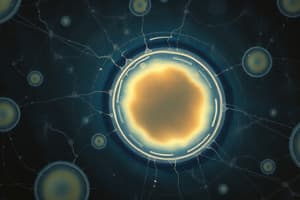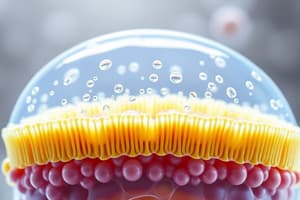Podcast
Questions and Answers
What is the main component of the plant cell wall?
What is the main component of the plant cell wall?
- Protein
- Cellulose (correct)
- Chlorophyll
- Starch
What happens to a living plant cell when it loses water through osmosis?
What happens to a living plant cell when it loses water through osmosis?
- It undergoes plasmolysis (correct)
- It remains the same
- It bursts
- It expands
What is the purpose of using iodine solution on onion peel during observations?
What is the purpose of using iodine solution on onion peel during observations?
- To protect the cells
- To kill the cells
- To enhance photosynthesis
- To provide color for better visibility (correct)
Why can plant cells withstand hypotonic external media without bursting?
Why can plant cells withstand hypotonic external media without bursting?
What observation would indicate that plasmolysis has occurred in plant cells?
What observation would indicate that plasmolysis has occurred in plant cells?
In which part of the cell would you primarily find chloroplasts?
In which part of the cell would you primarily find chloroplasts?
What method can be used to observe cheek cells under a microscope?
What method can be used to observe cheek cells under a microscope?
What occurs when Rhoeo leaves are placed in boiling water before observation?
What occurs when Rhoeo leaves are placed in boiling water before observation?
What does a selectively permeable membrane allow?
What does a selectively permeable membrane allow?
Which of the following substances cannot pass through the plasma membrane easily?
Which of the following substances cannot pass through the plasma membrane easily?
Study Notes
The Cell - Basic Unit of Life
- Electron microscopes provide high-resolution images of cells, allowing detailed study of cellular structures.
- CO2 and water move in and out of the cell through diffusion, a process driven by concentration gradients.
- The plasma membrane is selectively permeable, meaning it regulates the passage of substances, allowing certain molecules to enter or exit while blocking others.
Cell Wall
- Plant cells possess a rigid outer cell wall in addition to the plasma membrane, primarily composed of cellulose.
- Cellulose provides structural strength to plant cells.
- Plasmolysis occurs when living plant cells lose water, causing cell contents to shrink away from the cell wall.
Activities Observing Cell Structures
- Observing Rhoeo leaf cells under a microscope reveals chloroplasts, which contain chlorophyll.
- Adding a strong sugar or salt solution to living leaf cells causes water to be drawn out, demonstrating plasmolysis.
- Boiling Rhoeo leaves kills the cells, preventing plasmolysis due to the cells’ inability to absorb water afterward.
Nucleus and Staining Techniques
- Iodine solution enhances visibility of cell structures, staining components to reveal differences in cell regions.
- Safranin or methylene blue can also be used to stain cells for microscopy.
- Staining allows visualization of various regions within cells, with some appearing darker due to distinct chemical compositions.
Observing Cheek Cells
- Scraping the inner cheek provides cellular material that can be stained and analyzed under a microscope.
- The shape of cheek cells, typically rounded or irregular, can be documented for comparison.
- Living cells absorb water through osmosis, while dead cells do not; this demonstrates the functionality of cell walls in plant, fungal, and bacterial cells.
- Cell walls enable these cells to withstand hypotonic environments by preventing bursting from internal pressure due to water influx.
Studying That Suits You
Use AI to generate personalized quizzes and flashcards to suit your learning preferences.
Description
This quiz covers essential concepts related to cells, including the functions of the plasma membrane and cell wall. It also explores the movement of substances in and out of cells, specifically focusing on CO2 and water, as well as electron microscopes. Engage in discussions to deepen your understanding of these critical topics.




